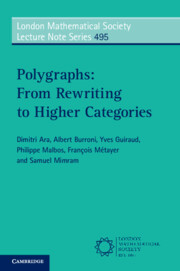Book contents
- Frontmatter
- Contents
- Preface
- Part I Fundamentals Of Rewriting
- Part II Coherent Presentations
- Part III Diagram Rewriting
- Part IV Polygraphs
- Part V Homotopy Theory of Polygraphs
- 19 Polygraphic Resolutions
- 20 Toward the Folk Model Structure: ω-Equivalences
- 21 The Folk Model Structure
- 22 Homology of ω-Categories
- 23 Resolutions by (ω, 1)-Polygraphs
- Appendices
- References
- Index of Symbols
- Subject Index
22 - Homology of ω-Categories
from Part V - Homotopy Theory of Polygraphs
Published online by Cambridge University Press: 18 March 2025
- Frontmatter
- Contents
- Preface
- Part I Fundamentals Of Rewriting
- Part II Coherent Presentations
- Part III Diagram Rewriting
- Part IV Polygraphs
- Part V Homotopy Theory of Polygraphs
- 19 Polygraphic Resolutions
- 20 Toward the Folk Model Structure: ω-Equivalences
- 21 The Folk Model Structure
- 22 Homology of ω-Categories
- 23 Resolutions by (ω, 1)-Polygraphs
- Appendices
- References
- Index of Symbols
- Subject Index
Summary
This chapter is about Métayer’s polygraphic homology of ω-categories. This homology theory was first defined in the following way: the polygraphic homology of an ω-category is the homology of the abelianization of any of its polygraphic replacements. Métayer then showed with Lafont that for every monoid, considered as an ω-category, its polygraphic homology coincides with its classical homology as a monoid. This result was then generalized to 1-categories by Guetta. In this chapter, it is proven that the polygraphic homology is the left derived functor of a linearization functor from the category of ω-categories to the category of chain complexes, respectively endowed with ω-equivalences and quasi-isomorphisms.
- Type
- Chapter
- Information
- Polygraphs: From Rewriting to Higher Categories , pp. 440 - 451Publisher: Cambridge University PressPrint publication year: 2025

